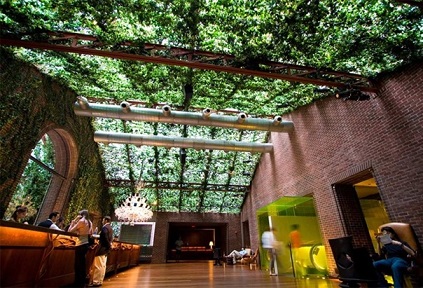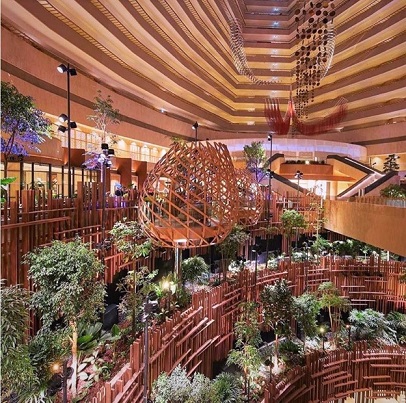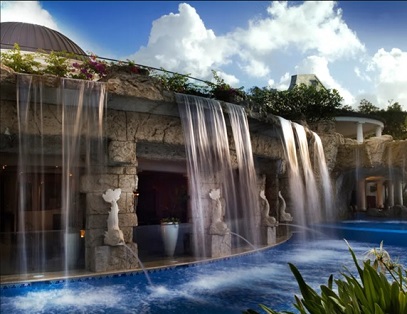NATIONAL REPORT—Ask a child to draw you a house and you’ll get something made up of rectangles and triangles. It’s still recognizable as a house you’d see on any street, but there’s nothing soft about it.
Sharp edges and harsh lines dominate the majority of human architecture. It’s an effective form of construction, but it has left us decidedly disconnected from the natural world. This disconnect isn’t harmful, but as the world shifts toward a greener and more sustainable future, we’ve started taking more inspiration from nature.
What is biophilic design and what are the benefits of this type of design in the hospitality industry?
What Is Biophilic Design?
No matter how we try to disconnect ourselves from the natural world, it’s always part of us. Biophilic design is the practice of adopting aspects of the natural world that are beneficial to the human experience and contribute to human health.

That last bit is significant when defining biophilic design. You may already be familiar with the concept of biophilic design without having a name for it. Adding plants to help purify the air within your home is one facet of biophilic design.
Many things in the natural world are detrimental to human health, such as poisonous plants and venomous animals, which are perhaps not the best option to add to interior design. On the other side of the coin, we are creatures of this world, and incorporating natural materials into our architectural designs has various benefits that we’ve overlooked in our quest to become more civilized.
How to Embrace Biophilic Design
Embracing and implementing biophilic design is a great way to improve customer experience and make the hospitality industry eco-friendly and sustainable. Here are some easy ways to bring the outdoors inside and embrace biophilic design.
Fresh Air
Sometimes, embracing biophilic design is as simple as opening the windows and letting some fresh air into your space. We do understand that this isn’t always possible in the hospitality industry, especially in high rises where opening the windows could become a safety concern.
Make every effort to bring some fresh air into your spaces, along with the sounds of nature that can have a calming and relaxing effect on anyone within earshot. Science also shows that breathing fresh air helps boost the immune system, making it easier to stay healthy.
Natural Light
Humans need sunlight to stay healthy. When you spend some time in the sun, your body manufactures the Vitamin D necessary for overall health and wellness. Specifically, encountering ultraviolet B (UVB) rays triggers the 7-DHC protein present in the skin, which converts into Vitamin D3.
Bringing natural light into indoor spaces can also shrink utility bills and the facility’s carbon footprint by reducing its reliance on artificial light sources. When paired with other design elements, such as lighter colors on the walls, natural light can also help spaces appear more spacious, allowing you to make the most of your square footage without knocking down any walls.

Greenery
Adding plants to any space is a fantastic way to adopt biophilic design principles. Indoor plants can act as air purifiers, removing everything from CO2 to dangerous volatile organic chemicals (VOCs) that might be present in the space.
Studies also show that spending time in rooms filled with indoor plants can help reduce stress and improve mental health. If you’re worried about having a black thumb, opt for plants that are easy to care for and hard to kill.
Natural Building Materials
This tip might be more expensive to implement, depending on your budget and whether you’re planning a renovation in the future. Choose natural building materials whenever possible. Timber, stone, rattan, bamboo, and cork, among other options, can all contribute to the overall biophilic design of your spaces.
When choosing these natural materials, make sure you’re buying from sustainable sources and work with contractors who employ green and sustainable construction practices.

Water Sounds
Is there anything more relaxing than the sound of trickling water? Water sounds, such as a gurgling brook or ocean waves, have always improved mental outlooks and positivity.
According to Dr. Rachel Buxton, this reaction isn’t surprising. She works at the Department of Biology at Carleton University in Ottawa. “From an evolutionary perspective, humans are hardwired to attend to signals of danger and security. And an environment that is filled with natural sounds feels safe and allows us to let our guard down.”
Softer Edges
Remember those comments we made about everything in human architecture having hard edges? Try to break up those hard lines whenever possible. Work to create a natural feel by focusing on furniture and decor items with soft edges, curved lines, and even some tiny imperfections like what we might see out in the natural world.
Color Psychology
Nature has a great variety of colors, but green is the dominant color when you’re out in the wild. Bringing this indoors can have all sorts of benefits. We associate green with nature and growth. In color psychology, green is both calming and refreshing. Research has shown that its calming effect is so prominent that you’ll often see green walls in restaurants or hotels to help people feel comfortable in new places.
Going Green, Literally
Biophilic design is gaining popularity and momentum in the private sector, but it can also benefit the hospitality industry. Take a closer look at your facilities and see which changes—either small or large—could change your spaces for the better.





